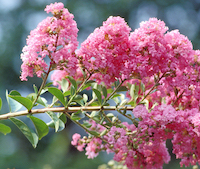Crape myrtles are one of my favorite landscape additions because they produce blooms that provide summer color, handle drought when established and, overall, have few issues with disease and insects.
Bloom color can range from red and pink to lavender and white with crape myrtles, giving you options in the landscape. Crape myrtles have size versatility too, with cultivars that can stay in the three-foot height range to some that will grow to 20 feet or more in height, therefore can be considered a shrub or a tree.
Some newer crape myrtle cultivars have improved flower color, better fall leaf color or better-looking bark, plus improved cold and disease resistance than some older varieties.
There are downsides to growing crape myrtles. Toward the end of summer, you may see sooty mold on crape myrtle leaves and stems. Sooty mold is a dark coating on foliage and stem areas. It can be removed by simply rubbing off the coating.
The sooty mold is caused by a fungus or excretion made by insects such as aphids. The sooty mold will cause few direct issues for the ornamental, but can make the crape myrtle less vigorous. You can reduce sooty mold problems by using aphid-resistant cultivars or insecticides labeled for the pests.
Crape myrtles can grow in some tough conditions but will grow and flower better in well-prepared soils. At planting, dig a large hole that is at least two times wider than the root ball. Set the plant in the hole no deeper than the crape myrtle grew in the field or container and backfill the hole with the same soil removed from the planting hole. Break up clods and remove rocks or other debris.
University of Georgia Cooperative Extension research shows that organic matter amendments are not necessary when planting in individual holes. Using amendments in the hole will encourage roots to stay in the hole area and will keep the roots from growing out into the surrounding soil. Amendments can help if they are mixed uniformly in the soil surrounding the planting hole.
Water the newly planted crape myrtle well to help settle the soil. Adding mulch will help conserve moisture, reduce weed problems and help insulate roots from cold or hot weather. Place three to five inches of pine straw, pine bark, shredded hardwood mulch or shredded leaves over the planting hole. Mulching beyond the planting hole is even more beneficial.
Established crape myrtles are considered drought tolerant, but watering in the first two months after planting is important. Watering during dry periods in the flowering season also will assist flowering efforts. Again, water completely at planting time and once a week in the absence of rainfall for the first two months.
Planting location is important, as crape myrtles perform better in full sun. Heavy shade can reduce flowering and growth and lead to more problems with sooty mold and powdery mildew on flower buds and new growth. Crape myrtles planted under large shade trees may not flower or grow well, as the tree will compete for soil moisture. Lack of overall sunlight and moisture will limit growth or lead to poor flowering.
Proper fertilization can be helpful. Crape myrtles can do well with a general-purpose fertilizer such as 8-8-8, 10-10-10, 12-4-8 or 16-4-8. For newly planted, one-gallon size crape myrtles, apply one teaspoon of fertilizer along the perimeter of the planting hole each month from March to August. For larger, established crape myrtles, use a broadcast approach one time in the spring.
You can apply 8-8-8 or 10-10-10 at a rate of one pound per 100 square feet or 12-4-8 or 16-4-8 at the rate of one-half pound per 100 square feet, according to UGA Extension experts. Do not overapply fertilizer. Overfertilization can cause excess growth and reduce flowering. It is better to fertilize right before a rain. If rain is not in the forecast, water well after fertilizer application. It is not necessary to remove the mulch when fertilizing.
For more information, contact your local UGA Extension office or see the publications at https://extension.uga.edu/publications.







